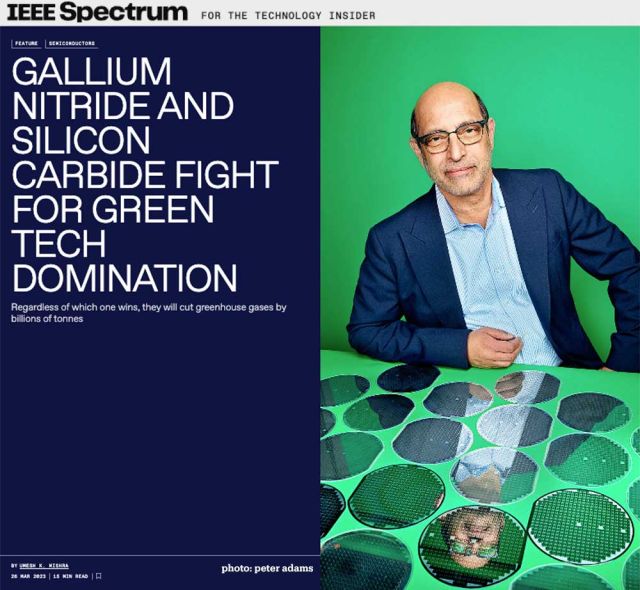Umesh Mishra – IEEE Spectrum
ECE Professor Umesh Mishra author of IEEE Spectrum semiconductor feature "Gallium Nitride and Silicon Carbide Fight for Green Tech Domination – regardless of which one wins, they will cut greenhouse gases by billions of tonnes"

Excerpt from IEEE Spectrum "Gallium Nitride and Silicon Carbide Fight for Green Tech Domination" by Umesh K. Mishra
Can advanced semiconductors cut emissions of greenhouse gases enough to make a difference in the struggle to halt climate change? The answer is a resounding yes. Such a change is actually well underway.
Starting around 2001, the compound semiconductor gallium nitride fomented a revolution in lighting that has been, by some measures, the fastest technology shift in human history. In just two decades, the share of the global lighting market held by gallium-nitride-based light-emitting diodes has gone from zero to more than 50 percent, according to a study by the International Energy Agency. The research firm Mordor Intelligence recently predicted that, worldwide, LED lighting will be responsible for cutting the electricity used for lighting by 30 to 40 percent over the next seven years. Globally, lighting accounts for about 20 percent of electricity use and 6 percent of carbon dioxide emissions, according to the United Nations Environment Program.
This revolution is nowhere near done. Indeed, it is about to jump to a higher level. The very semiconductor technology that has transformed the lighting industry, gallium nitride (GaN), is also part of a revolution in power electronics that is now gathering steam. It is one of two semiconductors—the other being silicon carbide (SiC)—that have begun displacing silicon-based electronics in enormous and vital categories of power electronics.
GaN and SiC devices perform better and are more efficient than the silicon components they are replacing. There are countless billions of these devices all over the world, and many of them operate for hours every day, so the energy savings are going to be substantial. The rise of GaN and SiC power electronics will ultimately have a greater positive impact on the planet’s climate than will the replacement of incandescent and other legacy lighting by GaN LEDs
Virtually everywhere that alternating current must be transformed to direct current or vice versa, there will be fewer wasted watts. This conversion happens in your phone’s or laptop’s wall charger, in the much larger chargers and inverters that power electric vehicles, and elsewhere. And there will be similar savings as other silicon strongholds fall to the new semiconductors, too. Wireless base-station amplifiers are among the growing applications for which these emerging semiconductors are clearly superior. In the effort to mitigate climate change, eliminating waste in power consumption is the low-hanging fruit, and these semiconductors are the way we’ll harvest it.
This is a new instance of a familiar pattern in technology history: two competing innovations coming to fruition at the same time. How will it all shake out? In which applications will SiC dominate, and in which will GaN prevail? A hard look at the relative strengths of these two semiconductors gives us some solid clues.
Read More:
- Why Power Conversion Matters in Climate Calculations
- Wide-Bandgap’s Advantages
- SiC Leads GaN in Power Conversion Today…
- …But GaN Is Gaining
- GaN vs. SiC: Handicapping the Contests
- The Wide-Bandgap Battle Is Just Beginning
IEEE Spectrum "Gallium Nitride and Silicon Carbide Fight for Green Tech Domination" (full article)
Umesh K. Mishra is an academic and an entrepreneur. In March, 2023, after 33 years on the faculty of the Department of Electrical and Computer Engineering, he was named the next Dean of the College of Engineering at the University of California, Santa Barbara. He is also chief technical officer of the gallium-nitride electronics company Transphorm. After earning a Ph.D. at Cornell University for research on gallium-arsenide devices, he had an epiphany. “I realized that the fundamental physics of microwave devices could be applied to power devices,” he says. “And that the impact on the world, and climate, would be much bigger.” Mishra is a Fellow of the IEEE and a member of the National Academy of Engineering. Among his honors are the IEEE’s David Sarnoff Award and Jun-ichi Nishizawa Medal.